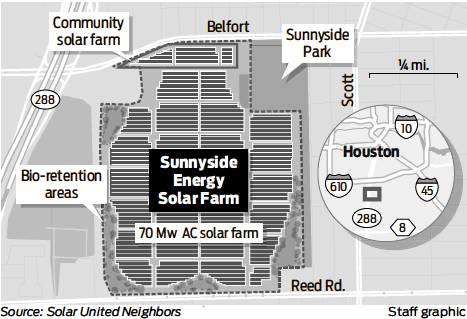There was an article in last week’s Houston Chronicle that gives me hope that “we the people” can do a lot to address climate change.

Sunnyside is a community in Houston about 10 miles south of downtown. First platted in 1912, and annexed by the city of Houston in 1956, Sunnyside included a landfill, an adjacent garbage incinerator, and several salvage yards. These elements created a “less than attractive” environment for residents and businesses. The incinerator has closed and the massive landfill, which was capped decades ago and covers an area that’s the size of more than 200 football fields, is now covered by hundreds of trees, overgrown shrubs and swarms of mosquitoes.
This site could soon become the state’s largest urban solar farm and a food source for a community that has long been under-served. In August, Houston Mayor Sylvester Turner announced that Sunnyside Energy, led by developer Dori Wolfe of Wolfe Energy LLC, has won a competition to be considered to re-purpose a 240-acre former landfill in Sunnyside. Subject to meeting certain terms and conditions, the team will construct one of the largest urban solar farms in Texas, if not the largest.
The Sunnyside project was selected as part of “Reinventing Cities,” a global-design competition in which major cities identify underutilized land for teams of developers, architects and neighborhood groups to come up with redevelopment proposals focused on resiliency and community.
According to Mayor Turner, “It is fitting that Sunnyside would be home to one of the largest urban solar farms in Texas. The project proposes to not only revitalize an underutilized piece of property that has been an eyesore to the community for years, but could also make Sunnyside a more complete, sustainable and resilient community.”

A commercial solar farm would take up the biggest share, about 220 acres, with another 12 acres reserved for community solar power for those who can’t afford it or don’t own a home that could benefit from solar panels. Another 2 acres would be set aside as space for the community to learn and grow produce not by digging in the contaminated soil, but by using aquaponics —a method of growing plants that uses water while at the same time raising aquatic animals such as fish. The project is estimated to begin in 2021, contingent on the lining up of investors.
To me the Sunnyside project is a great example of the opportunities that Jay Inslee and others who advocate the new “green economy” are talking about. Communities benefit from jobs and job training and share in the benefits of the project. Meanwhile the environment benefits because every kilowatt of energy that is produced by these solar panels is a kilowatt that does not have to come from the burning of fossil fuels – and all of those emissions that continue to warm our planet.
The price of solar has dropped by 70 to 80 percent over the past five years and this trend is expected to continue. As of January, the U.S. Environmental Protection Agency had identified more than 300 renewable energy projects on contaminated properties, landfills and mine sites, with close to 200 others in various stages of development or that have been suggested in public meetings.
But each of these potential projects needs “we the people” to be involved – to advocate for clean energy jobs and the clean environment they provide. It takes community leaders, engaged citizens, local officials and support from state and federal agencies. It takes new companies pioneering the innovation of new technologies for the future and investors willing to support these initiatives.
There are opportunities out there, and there is the opportunity to save our planet. That’s why I’m hopeful. And how appropriate that the largest urban solar farm in Texas may be in Sunnyside.
Wow this is great news of an amazing project! Thank you for bringing this to my attention. I will share with my friends 🙂
LikeLike
Thanks for the comment Hayley. The more I read about this project, the better I felt.
LikeLike
Its heartening to get a good news story on the environment. Great example of the slogan “think globally act locally.”
LikeLike
Thanks Mike… great and insightful phrase! I hope we’ll see more projects like this across the country.
LikeLike
Thank you, ‘Food guy’, for this good news story coming from the (fossil) energy capital of the world. It got me thinking: How much cooler will Sunnyside be with a large area allocated to a solar farm?
Converting the Sun’s rays to electricity means less energy available to produce the heat we suffer daily in Houston. I was surprised to find out that only 20% of the Sun’s light is converted to electricity using current photovoltaic technology.
A quick Google search uncovers research to improve solar cell efficiency using carbon nanotubes – an H-town (Rice) pioneered technology. Claims of 43% efficiency have been demonstrated with an eventual goal of 90%!
Maybe there is hope. At least I’ll sleep better tonight.
LikeLike
That’s some “cool” and promising research… thanks. I’ll sleep better tonight too. (Go Rice!)
LikeLike